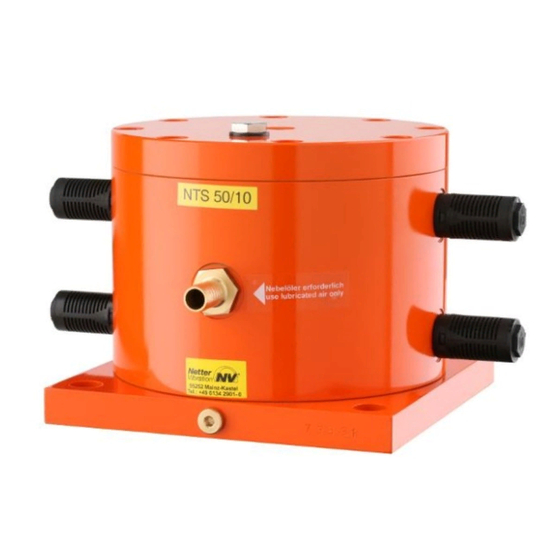Table of Contents
Advertisement
These operating instructions apply to:
Use and storage
Before installing the NTS read these instructions carefully. It is the basis for any action when dealing with
the NTS, and may be used for training purposes. The instructions should be subsequently stored at the
operation site.
Copyright
This documentation is protected by copyright.
reprinting and reproduction of the instructions, as well as parts thereof.
Operating instructions for
Netter pneumatic linear vibrators
Series NTS
Version 1
aluminium housing
NTS 80
NTS 75/01
NTS 120 HF
NTS 50/01
NTS 120 NF
NTS 70/02
NTS 180 HF
NTS 54/02
NTS 180 NF
NTS 50/04
NTS 250 HF
NTS 21/04
NTS 250 NF
NTS 50/08
NTS 350 HF
NTS 350 NF
NTS 100/01
Netter
Vibration reserves all rights such as translations,
Jan. 2021
No. 1895E
Page 1/9
Version 1
Version 2
steel housing
NTS 50/10
NTS 30/10
NTS 50/15
NTS 50/20
NTS 30/20
NTS 24/20
NTS 50/40
NTS 20/40
Advertisement
Table of Contents

Subscribe to Our Youtube Channel
Summary of Contents for NetterVibration NTS Series
-
Page 1: Table Of Contents
Jan. 2021 Operating instructions for No. 1895E Netter pneumatic linear vibrators Page 1/9 Series NTS Version 1 These operating instructions apply to: Version 1 Version 2 aluminium housing steel housing NTS 80 NTS 75/01 NTS 50/10 NTS 120 HF NTS 50/01 NTS 30/10 NTS 120 NF NTS 70/02... - Page 2 General information The pneumatic linear vibrators of the series NTS are hereafter referred to Designation as "NTS". Scope of Please refer to the delivery note for the scope of delivery. delivery Check the packaging for possible transport damage. In the event of dam- age to the packaging, check the contents for completeness and possible damage.
- Page 3 Safety The NTS are intended for generating linear vibrations. Intended use General applications are: loosening, conveying, sorting, compacting, sepa- rating bulk materials and reducing friction. NTS are used for emptying bunkers, as drives for conveyor troughs, sieves and vibrating tables. The NTS are designed for installation in machines and may only be put into operation, if it has been assured that the complete machine complies with the regulations of the machinery directive.
-
Page 4: Version
WARNING Compressed air A loosened hose which is under pressure can lead to personal injuries. ➢ Screw the hose lines on carefully. ➢ Check the hose lines and connections after one hour of operation and thereafter regu- larly (generally monthly). ➢... -
Page 5: Nts
Lubrication ISO viscosity class according to DIN ISO 3448, VG 5 to 15. Fill the mist lubricator with acid- and resin-free compressed air oil. Netter Vibration for all NTS (except NTS L). A mist lubricator is recommended by Recommendation for temperatures Specification for temperatures from 0 °C to 60 °C: from 0 °C to -20 °C:... -
Page 6: Version
Type: Mounting Tighten- Air supply line Air discharge line NTS ... thread or hole* Connection Hose Connection Hose torque thread [inch] size** thread [inch] size** [Nm] 30/10 18 mm* (for M16) G 3/8 DN 22 G 3/8 DN 25 50/15, 50/20, 22 mm* (for M20) G 3/8 DN 14... -
Page 7: Nts
Installation Observe the safety instructions in chap. Safety, from page 3 on. Standard installation Maintenance unit 3/2-way valve (NTS L: without mist lubricator) Notice: The NTS must lie completely on the surface. The mounting surface has to be flat (±0.1 mm flatness) and clean with no paint residues or burn-ins. Netter Vibration recommends mounting the NTS on a weld-on console or a glueing con- sole. -
Page 8: Nts
Setting the frequency The frequency of the NTS is set with the pressure regulator of the maintenance unit. The frequency is reduced by lowering the air pressure before the NTS. The centrifugal force is hereby also reduced. At the same time the amplitude remains almost constant. Adjustment of amplitude If required, install a throttle valve in the exhaust air line in order to adjust the amplitude of the NTS by throttling the exhaust air. -
Page 9: Version
Interval Action Monthly Check the function of the NTS. Check the function of the mist lubricator. Refill oil if necessary (except for the NTS L). Clean the filter of the maintenance unit and replace, if necessary. If necessary If necessary, clean the surface of the NTS with a wet cloth to remove dust deposits. * Observe the tightening torques (see Chap.









Need help?
Do you have a question about the NTS Series and is the answer not in the manual?
Questions and answers